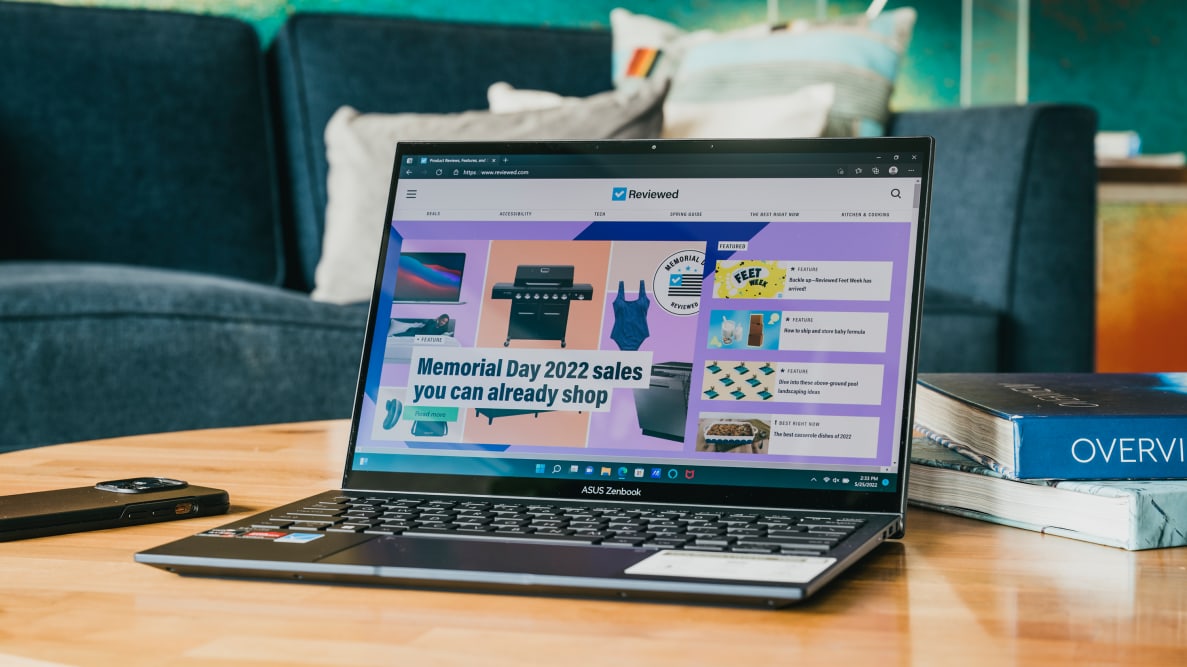Pros
-
Excellent OLED display
-
Strong performance
-
Enjoyable keyboard and touchpad
Cons
-
Mediocre battery life
-
Unimpressive design
-
Limited wired connectivity
About the Asus Zenbook S 13 OLED
Here are the specs of the laptop we tested:
- Processor: AMD Ryzen 7 6800U
- Graphics: AMD Radeon integrated graphics
- RAM: 16GB LPDDR5
- Storage: 1TB M.2 NVMe PCIe solid state drive
- Display: 13.3-inch, 2880 x 1800 OLED, 16:10 aspect ratio
- Wireless connectivity: Wi-Fi 6E, Bluetooth 5.2
- Wired connectivity: 3x USB Type-C with Power Delivery and DisplayPort Alternate Mode, 1x 3.5mm headphone jack
- Webcam: 1080p front-facing
- Battery: 67 watt-hours
- Weight: 2.43 pounds
- Size: 11.68 x 8.29 x 0.59 inches
The Asus Zenbook S 13 OLED’s key specification is in the name. It has an OLED display with a resolution of 2880 x 1800, an improvement over the 1080p resolution found in many mid-range laptops that offer OLED.
This laptop also has AMD’s new Ryzen 7 6800U processor. It promises a small lift in processor performance and, more importantly, a major gain in integrated graphics.
What we like about the Asus Zenbook S 13 OLED
The OLED display is excellent
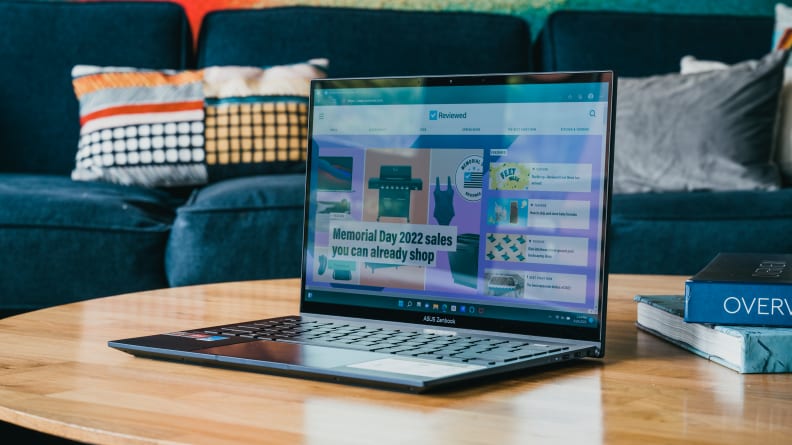
An OLED display is quickly becoming a must-have feature for modern laptops, and Asus’ Zenbook S 13 OLED demonstrates why. It has an excellent contrast ratio, deep black levels, and a massive color gamut with accurate color reproduction.
In short, it looks great no matter what you’re doing. YouTube? It’s great. 4K movies? It’s great. Games? It’s great. Photo editing? It’s great. Video editing? It’s great. I could go on, but I think you get the picture.
The Zenbook S 13 OLED has a 13.3-inch display with a 16:10 aspect ratio and 2880 x 1800 resolution. That works out to 255 pixels per inch, which is better than most Apple MacBook laptops and around 50%more pixel-dense than a 1080p OLED of the same size. It’s not quite 4K but, on a display this small, you’ll really have to lean in to see individual pixels.
I recorded a maximum brightness of just 366 nits, which is lower OLED laptops including the Dell XPS 13 OLED and Asus Vivobook Pro 14 OLED. This level of brightness is fine in most cases but can look dim competing against a sunlit window or harsh office lighting.
A faint speckled pattern is also present in the image, which is common to OLED laptops. It largely blends in at normal distances but may be visible in bright content. Viewing angles aren’t perfect with some color shifts at the extremes, but it’s hardly worse than a typical IPS display.
These flaws are barely noticeable and well worth the perks. It’s a vivid, lifelike display that offers a sense of depth that’s hard to beat. Apple’s Liquid Retina XDR display, found in the Apple MacBook Pro 14 and Pro 16, is the only superior alternative, but those are far more expensive.
AMD’s impressive RDNA 2 integrated graphics
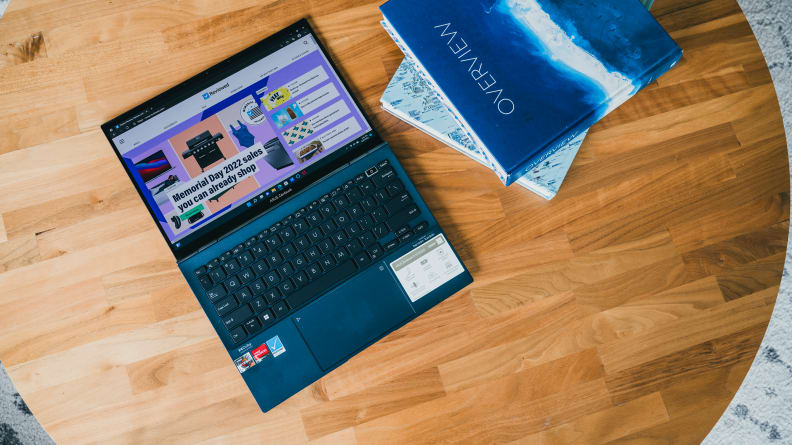
The Asus Zenbook S 13 OLED has AMD’s new Ryzen 7 6800U processor, but the real story is AMD’s improved integrated graphics. It is now based on the RDNA 2 architecture, the same used in the Xbox Series X and PlayStation 5 game consoles, and AMD’s Radeon 6000-series desktop graphics cards. This laptop has a particularly quick incarnation of AMD’s new integrated graphics called Radeon 680M.
It has 12 graphics cores and a maximum graphics frequency of 2200MHz. For comparison, the integrated graphics bundled in the outgoing Ryzen 7 5800U had just eight graphics cores and a maximum graphics frequency of 2000MHz. It looks like a big upgrade on paper—and it is.
The Asus Zenbook S 13 OLED reached a score of 5652 in 3DMark Fire Strike, a synthetic graphics benchmark. That’s not amazing but enough to help AMD retake a slight lead over Intel’s Xe integrated graphics which, in laptops like the Lenovo Yoga 9i, scores around 5000 in this test.
That 3DMark score translates to acceptable performance in many games. It achieved an average of 26fps in Shadow of the Tomb Raider at 1080p resolution and highest settings. Bumping things down to medium easily puts the frame rate above 30fps. Final Fantasy XIV and Civilization IV (two games I frequently play also reached above 30fps at 1080p and medium graphics settings.
If you want to play a truly demanding game, however, you will face obstacles. Cyberpunk 2077 is playable at an average above 30fps, but I had to set the game to 1600 x 900 resolution and Low detail. I’m impressed the game is handled even this well, as Cyberpunk 2077 is notorious for bringing last-gen game consoles to their knees, but it’s far from the ideal way to play the game.
Those looking for an advantage in GPU-accelerated productivity apps may be disappointed, however. Blender, a 3D graphics tool for creating scenes and animations, showed little difference between rendering on the CPU and GPU.
Decent improvement in processing performance
This AMD chip may deliver a big leap in integrated graphics performance, but its processor performance sees less improvement. This contrasts with Intel’s new 12th-gen processors, which are much quicker than their predecessors in some apps.
Geekbench 5, a synthetic processor benchmark, reached a single-core score of 1376 and a multi-core score of 6841. These figures are behind some alternatives, however; The Lenovo Yoga 9i with an Intel Core i7-1260P processor achieved scores of 1735 in single-core and 10184 in multi-core.
Apple’s MacBook Pro 13 with M1 chip also pulled ahead of AMD, scoring 1730 in single-core and 7355 in multi-core. (The new MacBook Pro 13 with an M2 chip, which we’ve yet to fully test, will likely widen Apple’s lead.)
The Zenbook S 13 OLED did a bit better in Cinebench R23, scoring 8747 in the multicore benchmark. That’s almost identical to the Lenovo Yoga 9i and snags an edge over the Apple MacBook Pro 13 with an M1 chip, which scored 7793.
This may seem disappointing given the improvements in recent Intel and Apple hardware, but the Ryzen 6800U remains a strong competitor overall; The Zenbook S 13 OLED isn’t quicker than competitors, but it holds its ground.
The keyboard is great, and the touchpad isn’t bad

The Asus Zenbook S 13 OLED is just under 0.6 inches thick, putting it in league with laptops like the Dell XPS 13 OLED and LG Gram series. Thin laptops have a reputation for mediocre keyboards because of the limited space available for key movement, but that’s not true here. The key feel is smooth, yet crisp, with a firm bottoming action.
I also enjoy the layout which, because of the taller 16:10 screen, provides a bit more space than older laptops with a traditional 16:9 widescreen. The palm rest is not quite large enough to fit my entire palm, but it does better than most laptops of the same size and doesn’t leave half my hand dangling in the air. There’s also plenty of space between each key, which makes it easier to identify them by touch.
Beneath the keyboard is a massive touchpad. Its surface has an unremarkable, plastic feel, but it’s responsive, and those who like Windows’ touchpad shortcuts will find plenty of space to use them. But because of its size, my palms often grazed the touchpad, which occasionally caused an unintended input, but not often enough to become frustrating.

The touchpad has an unusual feature found on many Asus laptops: a touch-activated Numpad. A shortcut in the touchpad’s upper right corner turns on a backlight that displays a Numpad. It works, but blocks using the touchpad for mouse input, which adds an extra step for users who prefer to not use an external mouse. (I’d give this laptop more leeway if it was a larger, less portable system, but most people don’t use an external mouse with a thin and light laptop.)
Still, those who need a Numpad will appreciate this feature—and it won’t bother those who choose to ignore it.
Lots of modern connectivity, reliable Wi-Fi
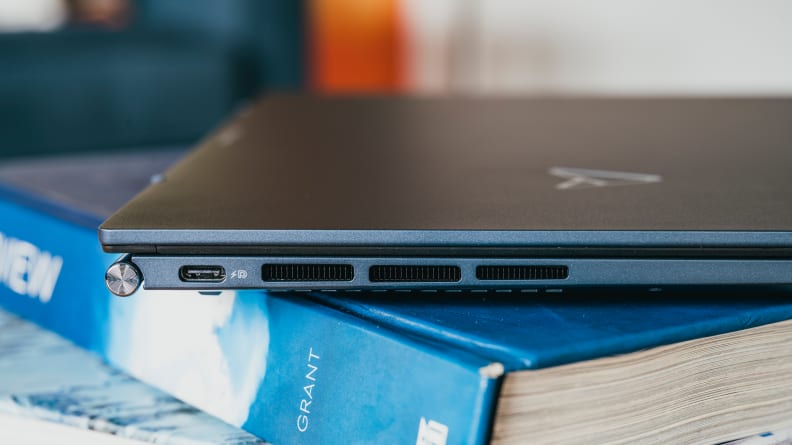
Like USB-C? Then you’re going to love the Asus Zenbook S 13 OLED.
It has three USB Type-C 3.2 ports with DisplayPort Alternate Mode and Power Delivery. That means you can connect a monitor or charger to any USB Type-C port on the laptop and expect access to both these features.
The Asus Zenbook S 13 OLED is particularly alluring for those with a USB Type-C monitor; Though reasonably quick, this laptop gets by with a 65-Watt power adapter, and USB Type-C monitors with Power Delivery use only 65 Watts
However, there’s no Thunderbolt 4 support. This is an issue common to the current line-up for AMD laptops, as AMD’s mobile chipsets don’t have built-in Thunderbolt 4 support. You’re missing out on the 40Gbps maximum transfer speed of Thunderbolt 4. Though not always a problem, it can become a bottleneck if you use multiple bandwidth-intensive connections, such as Ethernet and high-speed USB data, at once.
Wireless connectivity supports the newest Wi-Fi 6E standard. This can reach speeds better than a physical Gigabit Ethernet connection over short distances, though you'll need a Wi-Fi 6E router to see the added performance. The laptop’s Wi-Fi 6 performance is also solid, achieving a strong signal in all areas of my home and in a detached office fifty feet, and several walls, away from the router.
What we don’t like about the Asus Zenbook S 13 OLED
The look doesn’t live up to the price tag
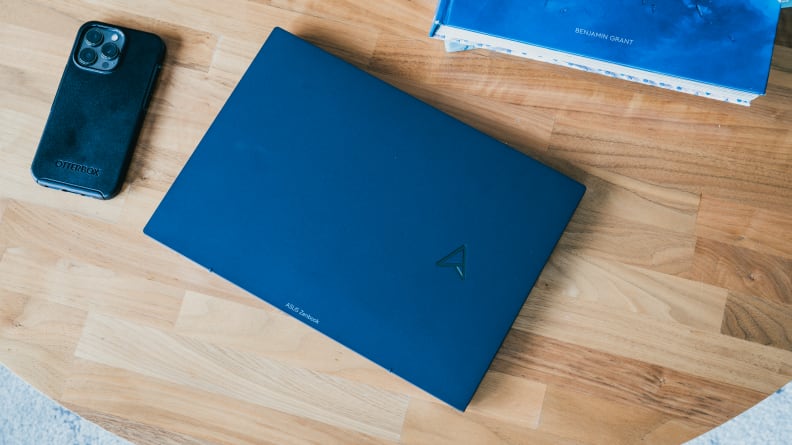
Asus’ Zenbook sub-brand was, for many years, defined by a flashy circular pattern etched into the lid of most laptops. It wasn’t subtle, but it was unique and helped Zenbook stand out from the crowd.
Unfortunately, Asus seems to be moving away from that design. The result is an utterly generic laptop. My review unit, which came with the Ponder Blue colorway, could easily be mistaken for a laptop sold at half its price, such as the Acer Swift series. There just isn’t much going on. Even Asus’ new Zenbook logo, which looks like a Star Trek comm badge or a mouse cursor, fails to stand out.
The same is true of build quality. There’s nothing wrong with it, exactly, but the laptop’s rigidity and its material-feel fall short of an Apple MacBook Pro 13 or Dell XPS 13.
Blame the laptop’s magnesium alloy body. This material, long used by Lenovo’s ThinkPad line but less common elsewhere, lacks the cool, reassuring feel of most metals. It’s easy to mistake it for plastic. Some competitors, like ThinkPads and Alienware’s new x14, mask this with a coating, but that’s not the case here.
It’s ironic, as magnesium alloy is a durable material that’s arguably superior to aluminum. It’s the reason why many modern laptops can achieve a weight below three pounds despite large batteries and cooling systems. Still, some people will judge a laptop’s quality by its feel, and the Zenbook S 13 OLED feels rather cheap.
Battery life could be better

A 67-watt-hour battery is stuffed into the Asus Zenbook S 13 OLED. That’s a healthy battery for a laptop of this size. Yet the laptop’s powerful processor squeezed the laptop dry quicker than I hoped.
Battery life came in at six hours and fifty minutes in our standard battery life benchmark, which uses a browser extension to automate web browsing. This simulates a modest workload, so the battery will drain more quickly with demanding apps.
My real-world observations were in line with the test. The laptop has plenty of battery life for lengthy meetings, most flights, and a half-day of remote work at your local coffee shop.
If you want to put in a full workday on the move, however, you will need to bring the power adapter with you. It’s a small adapter, at least, and because the laptop is charged over USB-C, you can buy an even more compact third-party adapter.
No wired connectivity for older devices
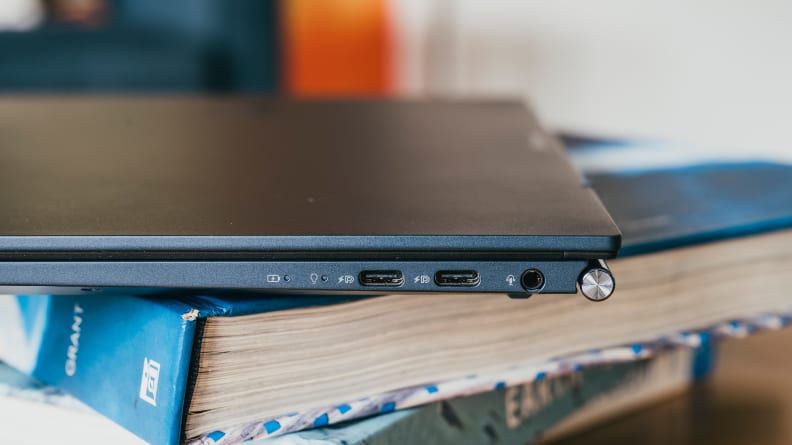
The Asus Zenbook S 13 OLED’s excellent modern connectivity comes at the expense of wired connectivity with older devices. This laptop is all-in on USB Type-C, so there are no USB Type-A ports for adding an older keyboard or mouse. (You’ll need a simple adapter like this one if you wanted to.) A dedicated video-out, such as HDMI or DisplayPort, is also missing, as is wired Ethernet. The sole concession to older devices is the lone 3.5mm combo audio jack.
On the plus side, all three USB-C ports are all capable of Power Delivery and DisplayPort Alternate Mode. That’s an advantage over PC laptops that choose to offer these features on a single USB-C port, and it makes adding a USB-C hub for legacy devices a bit less obtrusive.
It can get hot!
The Asus Zenbook Pro S 13 OLED has strong performance in many tests despite its thin profile. It’s also a fairly quiet laptop in both moderate and heavy use, but both of these together mean it generates a lot of heat.
Put simply, this laptop can become a real scorcher. It remains tame in idle or moderate workloads. Productivity apps and games, however, lead to a large hot spot that expands across the bulk of the keyboard and chassis. Only the front left and right corners remain somewhat cool.
I saw a maximum internal temperature of 96 degrees Celsius (204.8 F), which, though hot, is typical for a high-performance Windows laptop. The large hot spot can make the laptop unpleasant to use on your lap and leave you with sweaty palms.
Should you buy it?
Yes, the Zenbook S 13 OLED is quick, portable, and pleasant to use
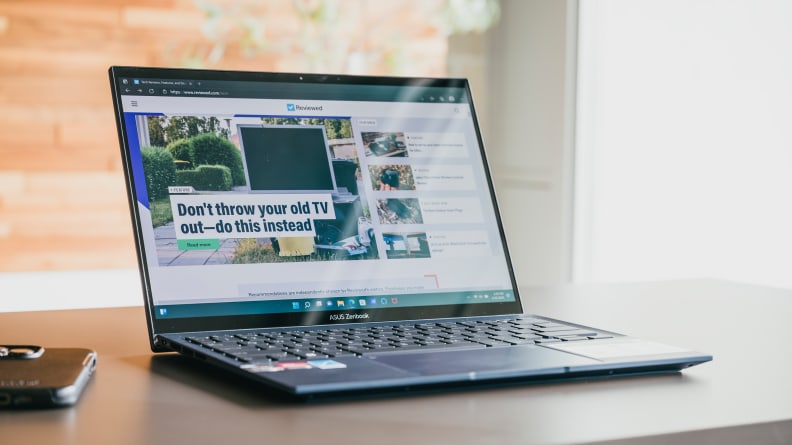
Refinement, elegance, and luxury are great to have in a laptop, but Asus’ Zenbook S 13 OLED is proof that function matters. It doesn’t look like much and feels like a $500 budget laptop, but it delivers in performance, display quality, and enjoyable day-to-day use.
The Zenbook S 13 OLED’s Ryzen 7 6800U processor deserves a share of the credit. It competes with the processor performance of new Intel and Apple alternatives and helps games perform better thanks to the new integrated GPU. You’ll like what you see, too, because the OLED display is excellent. It makes images look razor-sharp and wonderfully vivid.
Pricing is competitive with an as-tested MSRP of $1,299. That’s no bargain, but remember that this model has 16GB of RAM and 1TB of storage. You’ll pay hundreds more for similar RAM and storage in an Apple MacBook Pro 13 or Dell XPS 13. Those seeking an extremely capable yet slim laptop will be hard-pressed to find a better value.
Meet the tester
Matthew S. Smith is a veteran tech journalist and general-purpose PC hardware nerd. Formerly the Lead Editor of Reviews at Digital Trends, he has over a decade of experience covering PC hardware. Matt often flies the virtual skies in Microsoft Flight Simulator and is on a quest to grow the perfect heirloom tomato.
Checking our work.
Our team is here to help you buy the best stuff and love what you own. Our writers, editors, and experts obsess over the products we cover to make sure you're confident and satisfied. Have a different opinion about something we recommend? Email us and we'll compare notes.
Shoot us an email
